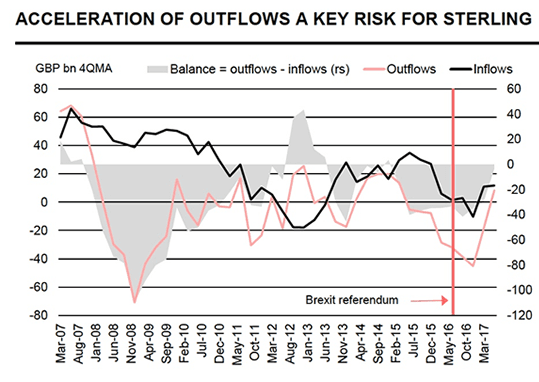Pound-to-Euro Rate Forecast Back Down at Multi-Year Lows warn UniCredit
- Written by: James Skinner

The Pound-to-Euro exchange rate is likely to remain under pressure ahead of the UK’s exit from the European Union say analysts at UniCredit bank in their latest foreign exchange forecast update.
According to analysts at the Italian bank's London unit, the Pound's current levels against the Euro remain generous in relation to where it will end 2017 and 2018.
While downside is seen, a period of consolidation in 2018 will likely form the low of a multi-year decline.
The Pound reached an eight year low at €1.0746 back in August before rising back towards the consolidative range we are presently witnessing.
Much will depend on how the Euro fares over coming months.
Driving the Euro higher against Sterling are expectations for a 'normalisation' of European Central Bank monetary policy that will see the Bank exit its gargantuan money-printing programme and commence raising interest rates.
This shift at the ECB - signalled at their October meeting 0 is forecast to provide upside pressure on the Euro over coming months as the return on monetary assets held in the Eurozone increases which disincentivises the export of Euros into higher-yielding jurisdictions.
Politics will remain the dominant driver of the Pound, with economics taking a back seat in the U.K., although a firming recovery on the continent is seen heralding a more hawkish pivot at the ECB which could give the Euro a lift during the next 24 months.
However, analysts at UniCredit concede predicting Sterling's path is fraught with difficulty.
“Sterling forecasts gave us the biggest headache when the team sat down to discuss our models and views,” says Dr. Vasileios Gkionakis, head of FX strategy research at UniCredit Bank.
“The main problem is the lack of a valuation anchor, because we simply do not yet know the extent of the structural damage inflicted on the UK economy by the EU referendum result and the associated surge in business and household uncertainty,” says Gkionakis.
Although economics will be an important driver for Sterling these next couple of years, UniCredit believe politics will overshadow everything else.
Until more is known about the UK’s future trading relationship with Europe, modelling economic growth and valuing the currency will involve assumptions based on political assumptions
“Sterling volatility is likely to rise as the two sides continuously measure their bargaining strengths, potentially flexing their muscles with announcements and headlines hitting the market, occasionally causing confusion which ultimately generates volatility,” Gkionakis warns.
Above: Any increase in Brexit uncertainty could see investors pull money from the U.K. which would in turn place renewed pressure on the Pound. Source: Unicredit.
Get up to 5% more foreign exchange by using a specialist provider by getting closer to the real market rate and avoid the gaping spreads charged by your bank for international payments. Learn more here.
End-Game
Key for the future direction of Sterling is whether a deal on future trade and transitioning to the future relationship can be agreed before the UK’s scheduled departure at the end of March 2019.
“The end-game is likely to be one in which both parties agree on a transition period so that the UK avoids dropping to the "void" from a cliff. Of course it is unlikely to be plain sailing, but once we get there, this is likely to manifest as a stronger support for Sterling,” says Gkionakis
The Pound could draw some support from an early agreement on transition, although in order for a deal to be struck, Prime Minister Theresa May must agree to pay Brussels a “divorce bill” or overcome the EU’s insistence on a financial settlement.
“Given our strong belief that the U.K. needs the E.U. far more than the E.U. needs the U.K., the UK government will likely cave-in to the EU’s proposal for the amount of the settlement bill in order to move on with trade talks,” says Gkionakis. “This may be perceived as supportive of sterling.”
Recent reports suggest that the 'Brexit cabinet' - a select group of cabinet ministers have agreed to increase the settlement amount the U.K. is willing to pay the E.U. in order to push talks forward.
It is hoped that the increased amount - no actual figure has been reported - will be enough for E.U. leaders to green-light the commencement of trade talks in early 2018.
On the back of these developments we have been reporting Sterling could find some near-term support. We would also argue that should talks progress and gradually yield clarity about the future, there is the chance that UniCredit's Sterling-bears are wrong-footed and the Pound continues to rise.
December is seen as a critical time for the talks as if transition and trade are to be agreed before the end of 2018, in time for the resulting agreement to be ratified in parliaments across Europe, then talks on both need to begin by year-end.
Assuming a transition deal is agreed over the coming months, setting the UK on course for an orderly departure from the EU, the risk premium carried by Sterling since the Brexit vote in June 2016 could begin to fade.
Forecasts for the Pound vs. Euro
“On balance, we forecast EUR/GBP rising to 0.92 in the first half of 2018 and consolidating towards 0.91 by end-2018,” says Gkionakis.
These EUR/GBP targets translate to around 1.0770 and 1.0880 for the Pound-to-Euro rate.
“In 2019, the likely agreement of the transition period should exert downward pressure on EUR/GBP, which, however, we think will be offset by expectations about the ECB raising rates in mid-2019,” Gkionakis adds.
The European Central Bank is broadly expected to set out a final end date for its quantitative easing (bond buying) program on or before its September 2018 meeting, which could lead markets to begin looking for an interest rate rise on the continent.
This would lift the Euro and could push the Pound-to-Euro rate down if it is not met by an offsetting action from the Bank of England.
“We think EUR/GBP will end 2019 around 0.90,” Gkionakis concludes; this gives us a final target of 1.11 in GBP/EUR.
Get up to 5% more foreign exchange by using a specialist provider by getting closer to the real market rate and avoid the gaping spreads charged by your bank for international payments. Learn more here.





